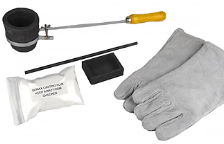For thousands of years, humans have been prospecting, mining and refining metals. The invention of smelting was a true technological advancement for mankind and marked the end of the Stone Age. Working with native metals such as copper, silver, gold, lead, and tin came first. These metals have fairly low melting points and the ability to cast and forge them was revolutionary. The Bronze Age was born when tin was mixed with copper, creating the first alloy and better weapons of war. 
As the centuries passed, metallurgists tried to figure out how to smelt iron. Iron doesn't occur in its native form and melts at a far higher temperature than any of the metals that had been smelted previously. By developing an ingenious process, iron was at last smelted, forged, and put to good use. Thousands of years have passed since the Iron Age began, and since then many exotic compounds have been created to support our quest for better and better technology.
Whether you've recovered natural gold (nuggets, flakes, wire gold, pickers, flour gold) or have unwanted jewelry or beat up old coins, you can smelt these at home. Choices for doing so include a small but high-powered electric furnace, a torch, or a small portable melting kiln kit you can also take into the field. To get started, you will also need basic gold smelting supplies such as flux, crucibles, tongs, ingot molds, and safety equipment.
Professional mining companies recover gold and other precious metals in quantities sufficient enough to pay refiners to do the smelting for them. But now you can smelt or melt your own gold, silver, and other metals at home!






